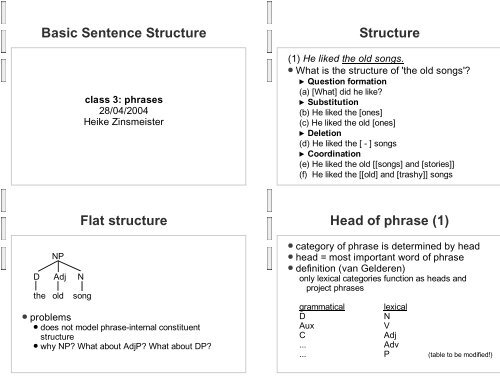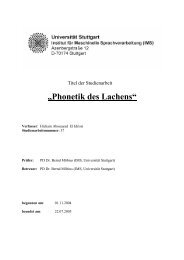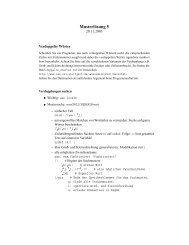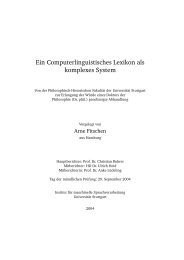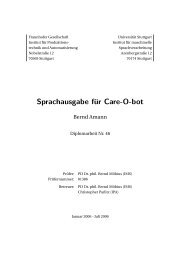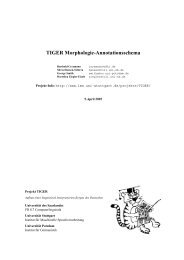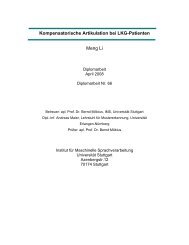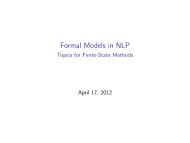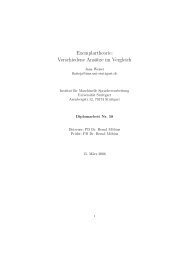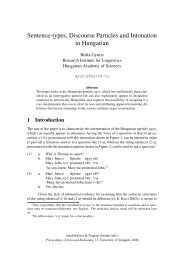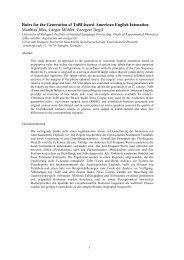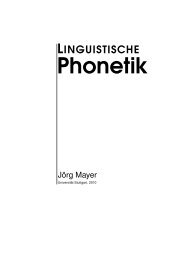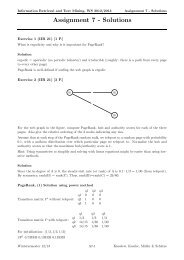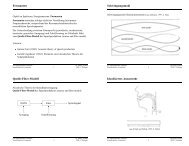Basic Sentence Structure Structure Flat structure Head of phrase (1)
Basic Sentence Structure Structure Flat structure Head of phrase (1)
Basic Sentence Structure Structure Flat structure Head of phrase (1)
Create successful ePaper yourself
Turn your PDF publications into a flip-book with our unique Google optimized e-Paper software.
<strong>Basic</strong> <strong>Sentence</strong> <strong>Structure</strong><br />
NP<br />
D Adj N<br />
the old song<br />
class 3: <strong>phrase</strong>s<br />
28/04/2004<br />
Heike Zinsmeister<br />
<strong>Flat</strong> <strong>structure</strong><br />
problems<br />
does not model <strong>phrase</strong>-internal constituent<br />
<strong>structure</strong><br />
why NP? What about AdjP? What about DP?<br />
<strong>Structure</strong><br />
(1) He liked the old songs.<br />
What is the <strong>structure</strong> <strong>of</strong> 'the old songs'?<br />
Question formation<br />
(a) [What] did he like?<br />
Substitution<br />
(b) He liked the [ones]<br />
(c) He liked the old [ones]<br />
Deletion<br />
(d) He liked the [ - ] songs<br />
Coordination<br />
(e) He liked the old [[songs] and [stories]]<br />
(f) He liked the [[old] and [trashy]] songs<br />
<strong>Head</strong> <strong>of</strong> <strong>phrase</strong> (1)<br />
category <strong>of</strong> <strong>phrase</strong> is determined by head<br />
head = most important word <strong>of</strong> <strong>phrase</strong><br />
definition (van Gelderen)<br />
only lexical categories function as heads and<br />
project <strong>phrase</strong>s<br />
grammatical lexical<br />
D N<br />
Aux V<br />
C Adj<br />
... Adv<br />
... P (table to be modified!)
<strong>Head</strong> <strong>of</strong> <strong>phrase</strong> (2)<br />
(1) He liked the old songs.<br />
<strong>Head</strong> <strong>of</strong> <strong>phrase</strong>?<br />
lexical category: old/Adj, songs/N<br />
Most important word?<br />
intuition?<br />
test: deletion (does not always work)<br />
(a) He liked the old.<br />
generic: 'old people'<br />
(b) He liked the songs.<br />
songs/N is the head <strong>of</strong> the <strong>phrase</strong><br />
old/Adj is the head <strong>of</strong> an embedded <strong>phrase</strong><br />
Constituents and <strong>phrase</strong>s<br />
constituents (preliminary description)<br />
intuitively formed groups <strong>of</strong> words<br />
<strong>phrase</strong>s<br />
well-defined linguistic constructs<br />
XP <strong>phrase</strong><br />
... / | \ ...<br />
X' intermediate level (optional)<br />
... / | \ ...<br />
X head (category determines type <strong>of</strong> <strong>phrase</strong>)<br />
constituent phrasal level<br />
[ NP the old songs] noun <strong>phrase</strong><br />
(the) [ N' old songs] noun-bar<br />
NP<br />
D N'<br />
Hierarchical <strong>structure</strong><br />
the AdjP N<br />
Adj songs<br />
old<br />
Brackets and tree <strong>structure</strong>s<br />
tree <strong>structure</strong>s correspond to nested<br />
brackets<br />
[ NP the [ N' [ AdjP old ] song]]<br />
D Adj N<br />
[ NP [ D the] [ N' [ AdjP [ Adj old]] [ N song]]]
Tree <strong>structure</strong>s<br />
also: trees, tree diagrams, or <strong>phrase</strong><br />
markers<br />
construction<br />
top-down<br />
bottom-up<br />
nodes<br />
root node (top node)<br />
terminal nodes, 'leaves'<br />
non-terminal nodes<br />
branches<br />
unary branching, binary branching, ternary ...<br />
underspecified subtree<br />
triangle, 'coat-hanger', 'clothes-hanger'<br />
Relations - precedence<br />
a node X precedes a node Y if X occurs to<br />
the left <strong>of</strong> Y<br />
X immediately precedes Y if<br />
(a) X precedes Y, and<br />
(b) there is no node Z that precedes Y and is<br />
preceded by X<br />
Relations - dominance<br />
A node X dominates a node Y in a tree<br />
diagram if we can trace a downward path<br />
from X to Y along the branches <strong>of</strong> the tree.<br />
X immediately dominates Y if<br />
(a) X dominates Y, and<br />
(b) there is no node Z that dominates Y and is<br />
dominated by X<br />
i.e., if we go down only one step<br />
Relative nodes<br />
mother node <strong>of</strong> node X?<br />
the node that immediately dominates X<br />
daughter node(s) <strong>of</strong> node X?<br />
node(s) that is/are immediately dominated by X<br />
sister node(s) <strong>of</strong> X?<br />
X and its sisters share the same mother node,<br />
i.e., they are immediately dominated by the same<br />
node
Example - tree<br />
NP 1 (Note: the indicies are just labels to<br />
D N' 1<br />
this<br />
AdjP N' 2<br />
(D)Adv Adj N 1<br />
distinguish the nodes)<br />
PP<br />
very spicy dish P NP 2<br />
from N 2<br />
India<br />
Example - relations (1)<br />
(1) Does NP dominate (D)Adv?<br />
1<br />
> yes<br />
(2) Does D dominate (D)Adv? > no<br />
(3) Does AdjP dominate (D)Adv? > yes<br />
(4) Does N' dominate (D)Adv?<br />
1<br />
> yes<br />
(5) Does NP dominate NP<br />
1 2<br />
> yes<br />
(6) Does D precede N' ?<br />
1<br />
> yes (even immediately,<br />
see next slide!)<br />
(7) Does NP precede NP ?<br />
1 2<br />
> no<br />
(8) Does AdjP immediately precede N /N ? > yes/no<br />
1 2<br />
(9) Does D precede (D)Adv? > yes (even immediately)<br />
(10) Does (D)Adv immediately precede P? > no<br />
Constituency (formal definition)<br />
constituent <strong>of</strong> X<br />
Y is a constituent <strong>of</strong> X iff (if and only if) X<br />
dominates Y<br />
immediate constituent <strong>of</strong> X<br />
Y is an immediate constituent <strong>of</strong> X iff X<br />
immediately dominates Y<br />
constituent A<br />
A set <strong>of</strong> nodes N form a constituent A, if A<br />
dominates all and only the nodes <strong>of</strong> A<br />
(based on Aarts 2001: 64f.)
Noun <strong>phrase</strong> NP (1)<br />
see e.g. slide 'example – tree'<br />
build around a noun<br />
head <strong>of</strong> NP = N, like dish<br />
additional elements<br />
determiner D, like the<br />
adjective <strong>phrase</strong>s AdjP, like spicy<br />
prepositional <strong>phrase</strong>s PP, like from India<br />
relative clauses (will be discussed later)<br />
(a) [The [child [who knows the answer]]] will win<br />
other clauses (will be discussed later)<br />
(b)[The [fact [that he won]]] was surprising<br />
Noun <strong>phrase</strong> NP (3)<br />
additional elements (cont.)<br />
apposition (= post nominal modification; i.e.<br />
functional term)<br />
(a) Anna, [my best friend], was here last night<br />
(b) Anna was here last night<br />
(c) My best friend was here last night<br />
(d) Anna, who is my best friend, was here last night<br />
(e) My friend [Anna] was here last night<br />
Noun <strong>phrase</strong> NP (2)<br />
substitution by various types <strong>of</strong> pronouns,<br />
e.g. she, he, it, who, what, this, those, any<br />
none, either, all, one/some, ...<br />
(Quirk et al. 1985:§12.10)<br />
exceptional: one/ones substitutes<br />
N'-constituents<br />
(Quirk et al. 1985: §12.15-16)<br />
(a) Have you any knives? I can get you sharp ones<br />
Different noun classes<br />
common nouns<br />
the girl, green tomatoes (countable)<br />
blue water, white flour (non-countable, mass noun)<br />
pronouns<br />
*the she, *green those<br />
proper nouns<br />
*the London, *the Cathy<br />
a tired student, *the tired Cathy<br />
van Gelderen: full <strong>phrase</strong>s (no N head)<br />
NP NP<br />
she Cathy
Proper nouns (1)<br />
(1) Would all the Janets in the room please raise their<br />
hands? (Aarts 2001: 30)<br />
(2) No John Smiths attended the meeting.<br />
(3) This John Smith lives in Brookline.<br />
(4) Greta knows thirteen John Smiths.<br />
(5) I have never met a John Smith.<br />
(6) John Smiths almost never have unlisted telephone<br />
numbers. (Baker 1995: 165f.)<br />
used as if it were a common noun (e.g. 'a<br />
person named John Smith')<br />
Proper nouns (3)<br />
what about the <strong>structure</strong> then?<br />
proper nouns<br />
typically stand alone (like mass common nouns<br />
and plurals)<br />
typically refer to specific persons, locations,<br />
objects, events etc.<br />
we keep things simple and follow van<br />
Gelderen<br />
proper nouns are (normally) simplex NPs<br />
Proper nouns (2)<br />
(1) Jack works for an Adolf Hitler.<br />
(2) The president <strong>of</strong> the company doubts that he will<br />
be able to hire any Einsteins. (Baker 1995: 166)<br />
(3) He's not the Jack I used to know.<br />
(Aarts 2001: 30)<br />
proper noun does not refer to certain<br />
person with a given name<br />
instead, it predicates a set <strong>of</strong> properties<br />
(related to the (in)famous or familiar person<br />
with the given name) on someone<br />
Names<br />
proper noun = single word<br />
name = complex <strong>structure</strong>, but grammatical<br />
unit<br />
examples<br />
(a) John Smith<br />
(b) Miss Marple<br />
(c) Mr John Smith<br />
(d) Pr<strong>of</strong>essor Dr Artemis Alexiadou<br />
(e) King's College<br />
(f) the British Broadcasting Corporation (the BBC)<br />
keep things simple:<br />
names = underspecified (flat) NPs
Noun Compounds - revised<br />
revision <strong>of</strong> last week's slide<br />
noun compounds (normally) behave as<br />
syntactic units<br />
even productive multi-word items will<br />
receive a flat simplex analysis<br />
(a) [ N wrist watch]<br />
(b) [ N bomb alert]<br />
Why? compare<br />
(c) [ N [ Adj rocking] [ N chair]] (v.Gelderen: N'-analysis)<br />
-> complex morphology but syntactic unit<br />
Adjective <strong>phrase</strong> AdjP (2)<br />
van Gelderen: degree Adverbs (D)Adv =<br />
grammatical category no phrasal proj.<br />
can be substituted by so<br />
can follow seem<br />
prices seem reasonably stable and will probably<br />
remain so<br />
AdjP<br />
AdvP Adj<br />
Adv stable<br />
reasonably<br />
Adjective <strong>phrase</strong> AdjP (1)<br />
e.g. very spicy<br />
build around an adjective<br />
head <strong>of</strong> AdjP = Adj, like spicy<br />
additional elements<br />
degree adverbs (D)Adv, like very<br />
prepositional <strong>phrase</strong>s PP<br />
(a) She is [proud [<strong>of</strong> her son]]<br />
clauses (will be discussed later)<br />
(b) She is [happy [to be here]]<br />
Adverb <strong>phrase</strong> AdvP (1)<br />
e.g. very quickly<br />
build around an adverb<br />
head <strong>of</strong> AdvP = Adv, like quickly<br />
additional elements<br />
degree adverbs (D)Adv<br />
van Gelderen: degree adverbs (D)Adv =<br />
grammatical category no phrasal<br />
projection<br />
no good substitution test
Adverb <strong>phrase</strong> AdvP (2)<br />
AdvP<br />
(D)Adv Adv<br />
very quickly<br />
Verb <strong>phrase</strong> (2)<br />
VP VP<br />
V NP V AdjP<br />
wrote D N seems (D)Adv Adj<br />
the letter<br />
VP very small<br />
V PP<br />
was P NP<br />
in D N<br />
the garden<br />
Verb <strong>phrase</strong> VP (1)<br />
build around a verb<br />
head <strong>of</strong> VP = verb<br />
additional elements<br />
obligatory vs. optional argument vs. adjunct<br />
noun <strong>phrase</strong>s<br />
adjective <strong>phrase</strong>s<br />
adverb <strong>phrase</strong>s<br />
prepositional <strong>phrase</strong>s<br />
auxiliaries<br />
clauses (to be discussed later)<br />
substitution by do so<br />
(a) he wrote a letter, and she did so too<br />
Prepositional <strong>phrase</strong> PP<br />
additional elements<br />
noun <strong>phrase</strong>s NPs<br />
(D)Adv like just, directly, close<br />
can be substituted by e.g. then, there, ...<br />
build around a preposition<br />
head <strong>of</strong> PP = P<br />
PP<br />
(D)Adv P'<br />
all P NP<br />
over the place
NP<br />
Coordination <strong>of</strong> <strong>phrase</strong>s (1)<br />
<strong>phrase</strong>s and categories can be coordinated<br />
as long as they are <strong>of</strong> the same kind.<br />
(van Gelderen 2002:41)<br />
(a) [She] and [her little brother] came in.<br />
(b) The dog went [under] and [over] the fence<br />
(c) I [read books] and [listened to music]<br />
(d) *I read [a book] and [to Janet]<br />
Coordination <strong>of</strong> <strong>phrase</strong>s (3)<br />
alternative: hierarchical <strong>structure</strong><br />
NP<br />
N and NP<br />
books N<br />
magazines<br />
(a) I read books yesterday [and magazines<br />
discussing political issues]<br />
Coordination <strong>of</strong> <strong>phrase</strong>s (2)<br />
<strong>structure</strong> is controversial<br />
van Gelderen: flat <strong>structure</strong><br />
example:<br />
(a) Books and magazines sell easily<br />
NP<br />
NP Coord NP<br />
N and N<br />
books magazines<br />
lexical vs. grammatical<br />
categories (revised)<br />
definition (van Gelderen)<br />
only lexical categories function as heads and<br />
project <strong>phrase</strong>s<br />
grammatical lexical<br />
D N<br />
Aux V<br />
C Adj<br />
(D)Adv Adv<br />
Coord P<br />
S
Today's key terms<br />
<strong>phrase</strong>s (NP, VP, AdjP, AdvP, and PP)<br />
head <strong>of</strong> <strong>phrase</strong><br />
flat vs. hierarchical <strong>structure</strong><br />
tree diagram<br />
relations in tree diagrams<br />
dominance<br />
precedence<br />
constituency (formal definition)<br />
substitution<br />
coordination<br />
Assignment 3: due 10/5/04<br />
1. The <strong>phrase</strong> presented in the 'example-tree' on the<br />
handout is structurally ambiguous. Give evidence for<br />
this and draw the alternative <strong>structure</strong>.<br />
2. Analyse the <strong>structure</strong> <strong>of</strong> the following <strong>phrase</strong>s. Give<br />
both labelled bracketing and tree <strong>structure</strong>s.<br />
(a) all the famous old songs<br />
(b) one <strong>of</strong> those pages<br />
(c) a lot <strong>of</strong> books<br />
(d) Peter's house in Geneva<br />
(e) the students' assignments on <strong>phrase</strong>s<br />
(f) She seems very foolish about money<br />
(g) The baby seemed very tired and somewhat<br />
cross<br />
References<br />
Gelderen, E. van. 2002. An introduction to the<br />
Grammar <strong>of</strong> English: Syntactic Arguments and sociohistorical<br />
background. Amsterdam/Philadelphia PA:<br />
Benjamins: chapter 3<br />
Tree <strong>structure</strong>:<br />
Aarts, Bas. 2001. English Syntax and Argumentation.<br />
Basingstoke/New York NY: Palgrave, Section 4.4,<br />
pp. 63-67.<br />
Further reading: proper nouns behaving as common<br />
nouns:<br />
Quirk, Randolph, Sidney Greenbaum, Ge<strong>of</strong>frey Leech,<br />
and Jan Svartvik. 1985. A comprehensive grammar<br />
<strong>of</strong> the English language. London: Longman: § 5.60 -<br />
5.64


